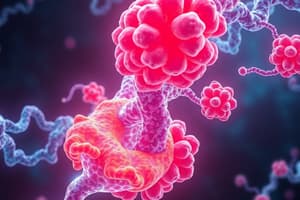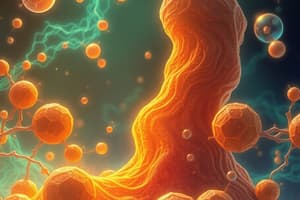Podcast
Questions and Answers
Which enzyme is responsible for the conversion of pyruvate to oxaloacetate in the first step of gluconeogenesis?
Which enzyme is responsible for the conversion of pyruvate to oxaloacetate in the first step of gluconeogenesis?
- Phosphoenolpyruvate carboxykinase
- Pyruvate carboxylase (correct)
- Malate dehydrogenase
- Pyruvate kinase
What is the role of malate dehydrogenase in gluconeogenesis?
What is the role of malate dehydrogenase in gluconeogenesis?
- To convert oxaloacetate to pyruvate
- To transport oxaloacetate across the mitochondrial membrane
- To phosphorylate oxaloacetate to phosphoenolpyruvate
- To convert oxaloacetate to malate for transport out of the mitochondria (correct)
Which molecule serves as the phosphate group donor in the conversion of oxaloacetate to phosphoenolpyruvate by phosphoenolpyruvate carboxykinase?
Which molecule serves as the phosphate group donor in the conversion of oxaloacetate to phosphoenolpyruvate by phosphoenolpyruvate carboxykinase?
- ADP
- GDP
- ATP
- GTP (correct)
Why is the conversion of pyruvate to phosphoenolpyruvate in gluconeogenesis not simply the reverse of the pyruvate kinase reaction in glycolysis?
Why is the conversion of pyruvate to phosphoenolpyruvate in gluconeogenesis not simply the reverse of the pyruvate kinase reaction in glycolysis?
What is the role of biotin in the conversion of pyruvate to oxaloacetate?
What is the role of biotin in the conversion of pyruvate to oxaloacetate?
Which of the following is NOT a glucogenic precursor?
Which of the following is NOT a glucogenic precursor?
Why is the conversion of pyruvate to phosphoenolpyruvate considered a bypass reaction in gluconeogenesis?
Why is the conversion of pyruvate to phosphoenolpyruvate considered a bypass reaction in gluconeogenesis?
What is the primary function of phosphoenolpyruvate carboxykinase in gluconeogenesis?
What is the primary function of phosphoenolpyruvate carboxykinase in gluconeogenesis?
Which of the following is NOT a precursor used for gluconeogenesis in animals?
Which of the following is NOT a precursor used for gluconeogenesis in animals?
What is the role of pyruvate carboxylase in gluconeogenesis?
What is the role of pyruvate carboxylase in gluconeogenesis?
Which enzyme is responsible for converting glycerol to glycerol 3-phosphate in gluconeogenesis?
Which enzyme is responsible for converting glycerol to glycerol 3-phosphate in gluconeogenesis?
Which bypass reaction occurs in gluconeogenesis to circumvent pyruvate kinase?
Which bypass reaction occurs in gluconeogenesis to circumvent pyruvate kinase?
Which compound can be directly converted into dihydroxyacetone phosphate in gluconeogenesis?
Which compound can be directly converted into dihydroxyacetone phosphate in gluconeogenesis?
In which tissue is the enzyme responsible for the final step of gluconeogenesis absent?
In which tissue is the enzyme responsible for the final step of gluconeogenesis absent?
What is the primary function of phosphoenolpyruvate carboxykinase in gluconeogenesis?
What is the primary function of phosphoenolpyruvate carboxykinase in gluconeogenesis?
Which condition primarily leads to an increase in glycerol use for gluconeogenesis?
Which condition primarily leads to an increase in glycerol use for gluconeogenesis?
What is the primary role of the oxaloacetate-malate shuttling system in gluconeogenesis?
What is the primary role of the oxaloacetate-malate shuttling system in gluconeogenesis?
Why is the conversion of pyruvate to oxaloacetate necessary in gluconeogenesis when lactate is the precursor?
Why is the conversion of pyruvate to oxaloacetate necessary in gluconeogenesis when lactate is the precursor?
Which enzyme catalyzes the conversion of fructose 1,6-bisphosphate to fructose 6-phosphate in gluconeogenesis?
Which enzyme catalyzes the conversion of fructose 1,6-bisphosphate to fructose 6-phosphate in gluconeogenesis?
Where is the enzyme glucose 6-phosphatase located?
Where is the enzyme glucose 6-phosphatase located?
Which of the following statements correctly describes the role of pyruvate carboxylase in gluconeogenesis?
Which of the following statements correctly describes the role of pyruvate carboxylase in gluconeogenesis?
What is the primary role of the mitochondrial isozyme of PEP carboxykinase in gluconeogenesis?
What is the primary role of the mitochondrial isozyme of PEP carboxykinase in gluconeogenesis?
Which of the following statements accurately describes the relationship between glycolysis and gluconeogenesis?
Which of the following statements accurately describes the relationship between glycolysis and gluconeogenesis?
Which of the following is NOT a glucogenic precursor that can be used in gluconeogenesis?
Which of the following is NOT a glucogenic precursor that can be used in gluconeogenesis?
Study Notes
Conversion of Pyruvate to Phosphoenolpyruvate
- Pyruvate is converted to phosphoenolpyruvate (PEP) during gluconeogenesis through a two-step process.
- The first step involves pyruvate carboxylase converting pyruvate to oxaloacetate in the mitochondrial matrix, requiring biotin.
- Due to the lack of efficient transporters for oxaloacetate, it is reduced to malate to facilitate its export from mitochondria.
- Malate is then re-oxidized to oxaloacetate in the cytosol by malate dehydrogenase, producing NADH from NAD+.
- Phosphoenolpyruvate carboxykinase catalyzes the conversion of oxaloacetate to PEP, using GTP as a phosphate donor and requiring Mg2+.
- The pathway utilized may vary depending on the glucogenic precursor; if pyruvate is derived from alanine or transported from the cytosol, similar steps occur.
- In cases where lactate is the precursor, it is first converted to pyruvate, then directly to PEP by the mitochondrial isozyme of PEP carboxykinase.
Conversion of Fructose 1,6-Bisphosphate to Fructose 6-Phosphate
- The second step of gluconeogenesis bypasses phosphofructokinase-1 (PFK-1) in glycolysis.
- Fructose 1,6-bisphosphate is dephosphorylated to fructose 6-phosphate by fructose 1,6-bisphosphatase, which requires Mg2+.
- This reaction occurs in the cytosol without ATP production.
Conversion of Glucose 6-Phosphate to Glucose
- The third step bypasses hexokinase from glycolysis.
- Glucose 6-phosphate is dephosphorylated to glucose by glucose 6-phosphatase, which resides in the endoplasmic reticulum (ER).
- Glucose 6-phosphate must be transported into the ER for dephosphorylation before glucose and phosphate are exported.
Substrates for Gluconeogenesis
- Non-carbohydrate precursors utilized in gluconeogenesis include most amino acids, glycerol, and TCA cycle intermediates.
- Lactate, produced by skeletal muscles and erythrocytes, is converted to pyruvate in the liver by lactate dehydrogenase for gluconeogenesis.
- Amino acids enter gluconeogenesis via transamination or deamination, producing pyruvate or TCA cycle intermediates.
- Glycerol, derived from the breakdown of triacylglycerols in adipose tissues, enters gluconeogenesis as dihydroxyacetone phosphate (DHAP).
- Glycerol is first phosphorylated to glycerol 3-phosphate using ATP, then oxidized to DHAP, producing NADH from NAD+.
- Prolonged fasting increases glycerol's contribution to gluconeogenesis, accounting for approximately 20% of glucose production.
Studying That Suits You
Use AI to generate personalized quizzes and flashcards to suit your learning preferences.
Related Documents
Description
Learn about the first bypass reaction of gluconeogenesis, where pyruvate is converted to phosphoenolpyruvate via pyruvate carboxylase and other enzymes.




